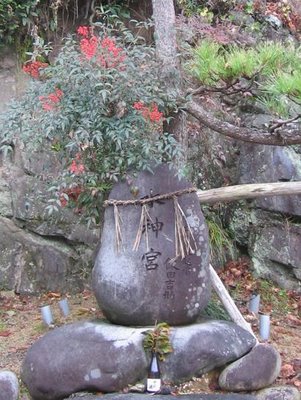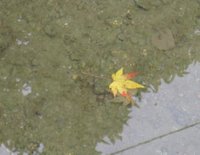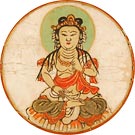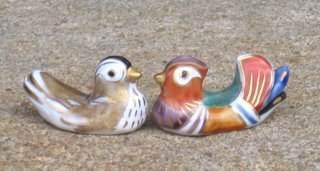. Tokugawa Ieyasu 徳川家康 . (1543 - 1616) .
:::::::::::::::::::::::::::::::::::::::::::::::::::::::::::::::::::::::::::::::::::::::::::::::::::::::
Toshogu Shrines,
Memorial Monuments for Tokugawa Ieyasu
東照宮 徳川家康
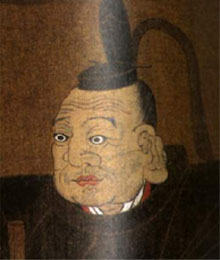
.......................... 1543 - 1616
http://www.samurai-archives.com/ieyasu.html
. Tokugawa Ieyasu 徳川家康 . (1543 - 1616) .
- Introduction -
Tokugawa Ieyasu is the founder of the Edo Shogunate, he was the first shogun and osthumously became some kind of protecting deity with his own shrine in the Nikko Mountains, north of Tokyo (an auspicious place to protect his city according to Chinese Feng-Shui Geomantic lore).
The correct spelling of the name should be Tooshoo-Guu in Nikkoo.
日光の東照宮
You can read more about the heroes who were active around 1600 to unite the many fiefdoms of Japan, the three most famous of them are Nobunaga, Hideyoshi and our Ieyasu.
http://www2.kanawa.com/japan/figure7.html
For our Haiku friends, here is the famous story to shed light on the temperament of these three:
When confronted with a nightingale in a cage, which would not sing, each had his own approach to this situation.
Nobunaga<>
If the bird does not sing, kill it!
Hideyoshi<>
If the bird does not sing, I will make it sing!
Ieyasu<>
If the bird does not sing, I will wait until it sings!
As you might imagine from the above episode, Ieyasu outlived and out-waited his opponents and then took over power, like a ripe apple falling into his hands.
Anyway, Ieyasu was an impressive figure and I will talk about him in another story, but here we are concerned with him after his death. His heirs and the nation needed a hero to unite for the future, so memorial shrines (Toshogu) were build, first in Kunoo-San. Another reason for building these luxurious shirnes, some critics say, was to make the local daimyoo, who were ordered with the buildings, spend so much money, they would not have a penny left to plot further fighting.
Tokugawa Ieyasu was obsessed with food and medicine to prolong his life. But he also liked to try new things, like the "tempora", tempura introduced by the Portugese missionaries.
The name refers to the time when the Catholics were not allowed to eat meat, quattuor tempora.
Ieyasu ate too much of it one day, became sick and died shortly after !
More details about his life:
http://www.samurai-archives.com/ieyasu.html
Latest research found that Ieyasu did not die of food poisoning or stomach cancer, but of a cancer of the pancreas.
:::::::::::::::::::::::::::::::::::::::::::::::::::::::::::::::::::::::::::::::::::::::::::::::::::::
Kunoo-San Toshogu 久能山の東照宮 Kuno San, Mount Kunô

Ieyasu died in 1616, and was buried at Mount Kuno-San in Shizuoka Prefecture according to his will. The shrine is situated on a steep hill overlooking the beach, but you can easily reach it nowadays via a ropeway from the other side, driving over some spectacular rock formations, called the “Rocks like folding screens” (byoobu-yama).
Anyway the detailed story of Kunoo-San (various spellings) is here:
https://www.toshogu.or.jp/
Mount Kunô (Kunôsan)
Utagawa Kuniteru II (Kunitsuna II; here signed as Kunitsuna)
:::::::::::::::::::::::::::::::::::::::::::::::::::::::::::::::::::::::::::::::::::::::::::::::::::::
Ueno Toshogu 上野の東照宮

There is another famous Toshogu Shrine at Ueno, in the heart of Tokyo, built in 1650. This is the most convenient of the Toshogu Shrines to visit on a short Japan trip, and it gives you a vivid impression of this particular style of architecture, which I would like to call “Chinese Baroque”, overloaded with decorations, a symphony in colours and shapes, just overwhelming in all the details.
Look at it here:
http://www.edo-ya.com/guide/spots/toshogu.htm
徳川家康は元和2年(1616)4月17日駿府(静岡市)で死去し,死後日光東照宮に葬られた。その威光を末永く示すため,各所に家康を祀る東照宮が建立されたが,江戸では江戸城内紅葉山と浅草寺境内に東照宮が建てられた。寛永3年(1626)伊勢国津藩主藤堂高虎は,幕府の許可を得て自邸内に上野東照宮を造り,一般市民にも参拝させていた。寛永19年に浅草にあった東照宮が浅草寺からの火で類焼したため,急遽上野の東照宮が大名諸侯の参詣の場所となる。正保3年(1646)には正式に東照宮の宮号も授けられた。 しかし三代将軍家光は,高虎の建てた東照宮が気に入らず,社殿の全面造り替えを命じ,慶安4年(1651)4月に完成した。社殿は国重要文化財の指定を受け,唐門,透塀,拝殿,幣殿,本殿からなり,日光東照宮と同じ権現造りが用いられた。写真は拝殿で,その桁行七間(15.2m),梁間三間(6.3m)本殿の前方に建ち,本殿との間を石の間でつなぐ「権現造り」である。唐門の透塀に囲まれ,入母屋造り正面千鳥破風といった大きな銅葺の屋根である。黒漆の腰組が縁を保ち,柱から唐戸に至るまで金箔を使い,長押上段は鳳凰が彫刻され,金銀緑青からなる極彩色となっている。唐草蒔絵の長押,それに中央を高くした折上格天井は,狩野探幽筆の彩色唐獅子が描かれている。拝殿内陣正面の「東照宮」の勅額は,紺青と緑青の中に純金で書かれ,後水尾天皇の筆で慶安4年に納められたものである。
http://www.asahi-net.or.jp/~dz3y-tyd/jinjya/tousyouguu/tousyouguu.html
Woodblock Print of the Pagoda by Kawase Hasui
http://www.wlotus.com/KawaseHasui/Ueno%20Toshogu%20Shrine%20in%20Spring.htm
The Peonia Gardens at Ueno Toshogu
Reference
:::::::::::::::::::::::::::::::::::::::::::::::::::::::::::::::::::::::::::::::::::::::::::::::::::::
Kawagoe Toshogu 川越東照宮 - Senba Toshogu 仙波東照宮

There are many Toshogu Shrine in Japan. But this shrine is one of the top three of Toshogu Shrine in Japan. The others are Kunosan Toshogu in Shizuoka Pref. and Nikko Toshogu in Tochigi Pref. TOKUGAWA Ieyasu was preliminarily buried at Kunosan. Since then, in accordance with the last words of Ieyasu, he was buried at Nikko. On the way to Nikko, the funeral procession stopped at Kawagoe. As a result anotherToshogu Shrine was constructed at Kawagoe.
His Buddhist priest-adviser Tenkai resided in the temple Kita-In in Kawagoe and had the Toshogu Shrine built in the compound to perform special rituals for four days, before the remains of Ieyasu moved on.
The Koma-Inu 狛犬of the shrine are especially beautiful.

. Tenkai 天海 - Jigen Daishi 慈眼大師 . (1536-1643)
Here in Kawagoe, Daruma meets Ieyasu at the annual Daruma Fair on January 3.
You can see the Daruma market and beautiful pictures of the Shrine in snow and the interiour with the superb black laquer decorations. The Hollycock crest (aoi no go-mon) is the one of the Tokugawa Family until today.
At the Temple Kita-In 川越喜多院 there is a big Daruma Market too.

Look at the many pictures on this link.
http://www.ne.jp/asahi/yume/dreams/main/English_Kawagoe_daruma_2003.htm
Jizoo with Daruma お地蔵様とだるま
http://2.pro.tok2.com/~dreams/photo/ztk/kawagoe/03_daruma/t_daruma_045.jpg
The Hollycock crest (aoi no go-mon) is the one of the Tokugawa Family until today.
http://2.pro.tok2.com/~dreams/photo/ztk/kawagoe/03_daruma/t_daruma_027.jpg

:::::::::::::::::::::::::::::::::::::::::::::::::::::::::::::::::::::::::::::::::::::::::::::::::::::
Kishu Toshogu 紀州東照宮
In Wakanoura, Wakayama
. Wakanoura matsuri 和歌浦祭 Wakanoura Festival .
. . . and the Saiga dance 雑賀踊
:::::::::::::::::::::::::::::::::::::::::::::::::::::::::::::::::::::::::::::::::::::::::::::::::::::
Nikko Toshogu (Nikkoo Tooshoo-Guu)
日光東照宮
This is of course the most famous of them all, with extensive buildings nestled in the mountains of Nikko, now a national park with the great Kegon Waterfall, Lake Chuuzen-ji and many more spectacular places. In Nikko you find the famous three monkeys: no see, no hear, no speak. And the sleeping cat, which is watching over the mice in the area. All the wonderful carvings are said to have been made by a master carver who had only his left arm to do all these masterpieces, Hidari-Jingoroo.
“The grand shrine at Nikko, the Toshogu, was built for Tokugawa Ieyasu after his death in 1616. Ieyasu left behind detailed instructions for his shrine, which were, for the most part, carried out by his grandson Iemitsu in the 1630s. This site contains about 30 buildings, while the entire Nikko site contains many more, including the Taiyuin which Iemitsu had built as a mausoleum for himself in 1653.”
Here you find a lot of pictures with Enlish explanations.
Nikko area belongs to the World Heritage.
http://www.city.nikko.tochigi.jp/heritage/english/w_top.htm
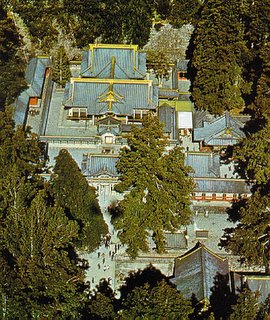
Walk around the temple compound.
http://www.columbia.edu/itc/ealac/V3613/nikko/html/walking_tour.html
http://www.columbia.edu/itc/ealac/V3613/nikko/html/ieyasu_s_toshogu.html
More pictures
http://www.japan-guide.com/a/html/nikko_e.html
http://www.spm.co.jp/kantou-travel/kanto/tosyogu.htm
The complete picture tour, including the sleeping cat.
http://pictures.nicolas.delerue.org/japan/20040808_Nikko/
Sleeping Cat
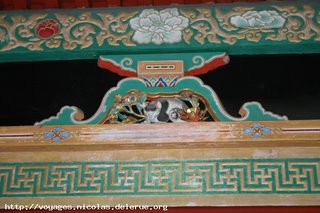
http://pictures.nicolas.delerue.org/japan/20040808_Nikko/Nikko_5221.html
Three Monkeys and MANY MORE

http://web-japan.org/atlas/architecture/arc05.html
http://www.reggie.net/photo.php?albid=841&ph=4161644
There is a map with all the Toshogu Shrines of Japan.
http://www.toshogu.net/map.htm
And on this list, you can click on most of the names on the left to go further.
http://www.toshogu.net/list.htm
Matsuo Basho in Nikko
日光. (futa ara) (二荒) .. Fudara
BAKU 獏 or 貘 a kind of tapir
It eats our nightmares, but also:

source : kotonara
With more photos from Nikko
Since the BAKU eats iron, copper and all kinds of metal, it was depicted at the Toshogu many times in the hope it would prevent the making of weapons and thus prevent war against the Bakufu.
:::::::::::::::::::::::::::::::::::::::::::::::::::::::::::::::::::::::::::::::::::::::::::::::::::::
Nikkoo Kaidoo 日光街道 Nikko Kaido Road
Nikko Reiheishi Kaido 日光例幣使街道 for imperial messengers
Nikko Onari Kaido 日光御成街道 for the Shogun
. Roads from Edo to Nikko .
:::::::::::::::::::::::::::::::::::::::::::::::::::::::::::::::::::::::::::::::::::::::::::::::::::::::

sake no izumi 酒の泉 Sake Spring
at Takinoo Shrine 滝尾神社, a subordinate shrine of Nikko Futarasan Shrine
別宮滝尾神社 酒の泉【さけのいずみ】
Sake brewed with this water is especially delicious.
- source : www.mct.gr.jp/world_h/futarasan
:::::::::::::::::::::::::::::::::::::::::::::::::::::::::::::::::::::::::::::::::::::::::::::::::::::
. Teri-furi ningyoo 照り降り人形 "weather forecasting dolls" .
and this stone from Nikko
Terifuri-ishi - Weather Forecast Stone 照り降り石 日光
:::::::::::::::::::::::::::::::::::::::::::::::::::::::::::::::::::::::::::::::::::::::::::::::::::::
ekiben 駅弁 station lunch at Nikko
masu sushi 日光鱒寿し Sushi from masu, local trout
placed on a layer of local yuba tofu skin and wrapped in large bamboo leaves.
the fish is marinated in salt and then in vinegar to give it its appetizing color.
The producer of this bento makes others too, all with ingredients from the area.
If he can not get local fish, he uses some sent over from Tsukiji market in Tokyo.

WASHOKU ... Japanese Food SAIJIKI
:::::::::::::::::::::::::::::::::::::::::::::::::::::::::::::::::::::::::::::::::::::::::::::::::::::
H A I K U
元和2年4月17日(1616年6月1日)June 1
kigo for mid-summer
Ieyasu Ki 家康忌 Ieyasu Memorial Day
. Memorial Days and Famous Poeple .
kigo for early summer
Nikkoo Tooshooguu sai
日光東照宮祭 (にっこうとうしょうぐうさい)
Festival at Toshogu in Nikko
Nikkoo sai 日光祭(にっこうさい)Nikko festival
Tooshooguu sai 東照宮祭(とうしょうぐうさい)Toshogu festisval
yoinarisai 宵成祭(よいなりさい)"coming on the night before"
togyosai 渡御祭(とぎょさい)"honorable parade of the main deity"
May 17, 18
It used to be on the death aniversary day of Ieyasu, according to the lunar calendar on April 17.
On the night before the festival, the mikoshi of the three main shrines are carried to shrine Futarasan jinja to spend the night there (yoinarisai).

quote
A procession of 1,000 samurai warriors staged at a world heritage site
Shunki Reitaisai (Grand Festival of Spring)
The highlight of this festival is the procession called Hyakumono-Zoroe Sennin Gyoretsu of some 1,000 men dressed as samurai warriors on the 18th. Nikko Toshogu, which is registered as a World Heritage Site, is dedicated to Tokugawa Ieyasu (1542-1616) who founded the Tokugawa Shogunate in Edo (Tokyo). This procession reproduces the scene of his grave being transferred from distant Shizuoka Prefecture to Nikko in accordance with Ieyasu's will.
The procession departs from a shrine called Otabisho by the Shinkyo Bridge located to the south of Futarasan-jinja Shrine. It is led by three portable shrines which carry the spirits of the three Shoguns, including Tokugawa Ieyasu. They are followed by Shinto priests on horseback and samurai warriors clad in full armor. There are no special attractions, but this enhances the grandiosity and elegance of the procession all the more, impressing the spectators with the dignity of the samurai warriors.
It is also worthwhile listening to the ancient court music and viewing the dance performances which are carried out upon the arrival of the portable shrines at Toshogu Shrine. The 17th features yabusame, with archers dressed in samurai style shooting at targets while on horseback. A similar procession is held in October but on about half the scale of the spring procession.
source : www.pelican-travel.net
.................................................................................
Toshogu shrine pines
I try to stay as still -
mist and dew
Alan Summers, Area 17, 2006
:::::::::::::::::::::::::::::::::::::::::::::::::::::::::::::::::::::::::::::::::::::::::::::::::::::
. Nikkoo kisuge 日光黄菅 Amur Dailily .
lit. "yellow Suge from Nikko"
zenteika 禅庭花(ぜんていか)"Zen garden flower"
setteika せっていか
Hemerocallis middendorffii
:::::::::::::::::::::::::::::::::::::::::::::::::::::::::::::::::::::::::::::::::::::::::::::::::::::
. Tokugawa Ieyasu 徳川家康 . (1543 - 1616) .
. WKD - Saijiki for Festivals and Ceremonies
. Law and Order 法律 - Pax Tokugawa .
The Edo Period
. Edo bakufu 江戸幕府 The Edo Government .
[ . BACK to WORLDKIGO . TOP . ]
[ . BACK to DARUMA MUSEUM TOP . ]
:::::::::::::::::::::::::::::::::::::::::::::::::::::::::::::::::::::::::::::::::::::::::::::::::::::

